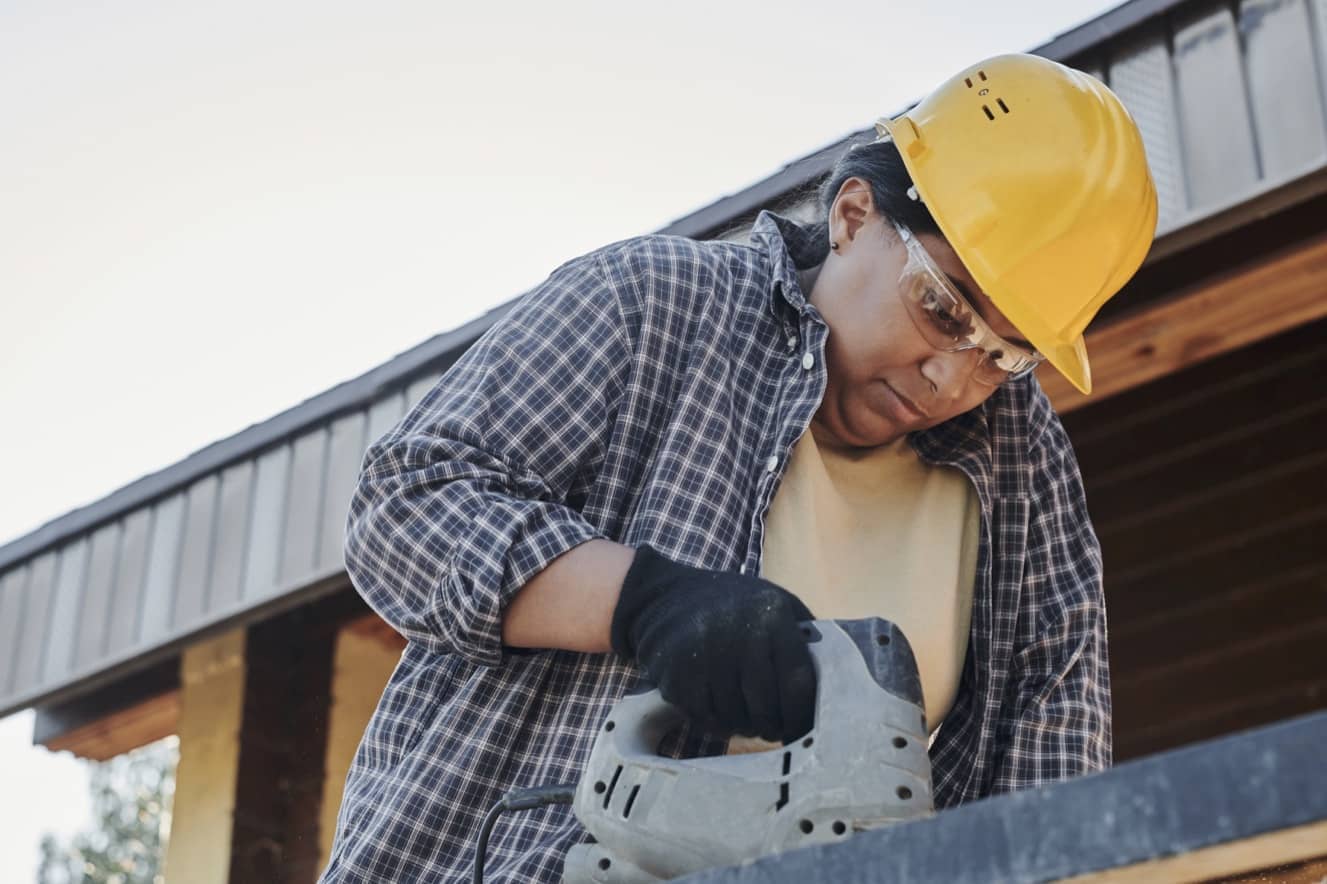
www.buildingsandcities.org/insights/commentaries/procurement-workforce-diversity.html
Using Procurement to Promote Workforce Diversity

Government legislation and procurement are being used to influence the private sector's diversity and equality practices.
Tessa Wright (Queen Mary University of London) describes how public procurement can be used to create a more diverse construction workforce. Initial findings from a Buying Social Justice research project help explain how countries can improve the diversity of their construction industries.
The emergence of the social value agenda can promote justice, equality and social cohesion in the built environment. A useful working definition of social value is 'the economic, social and environmental wellbeing of the relevant area' which encompasses a need to create an inclusive economy and equal employment opportunities for local people.
The construction sector globally remains heavily male-dominated and, apart from in some South Asian countries, women are significantly less likely to be employed in the manual trades. There has been some increase in women's participation in professional occupations in many countries, but the UK continues to have similar patterns of female under-representation as in other developed countries such as Australia, Canada and the US and in Europe.
In the UK, women still account for only 14% of the total construction workforce of over 2 million people and are found in even smaller numbers in the building trades (where only 1 to 2% are women). Ethnic minorities are also underrepresented, making up just 7% of the construction workforce (compared to 18% of the UK population). However, the construction sector now recognises that recruiting a more diverse workforce leads to greater innovation, improved performance and access to a wider talent pool (McKinsey & Company 2020; CIOB 2021).
A role for the public sector
As a client, governments have influence on the private sector though its purchase (or procurement) of goods, works and services. For example, UK central and local governments, annually, spend roughly £295bn on procurement from the private sector. Previous research has shown that UK Government purchasing power can be a lever for change, producing increased employment of women and black and minority ethnic (BME) workers in the construction of the London Olympic Park, Crossrail and other infrastructure projects (Lulham 2011; Pascutto 2016; Wright 2015; Wright & Conley 2020). In Northern Ireland increased employment opportunities were achieved by a procurement pilot tackling the higher rate of unemployment among Catholics (McCrudden 2011; Erridge 2007). Various programmes in the United States requiring affirmative action for ethnic minorities and women working on federally-supported construction projects also increased employment of black people and women (Erridge & Fee 1999; Price 2002; 2004; Eisenberg 2004).
Legal and policy contexts
The distinct legislative and political contexts for public procurement in different countries produce different outcomes (Wright et al. forthcoming). In the UK the Buying Social Justice1 project is exploring best practice in the three nations of England, Wales and Scotland that have developed distinctive legislative environments for public procurement. For instance, the UK's Public Sector Equality Duty (PSED), introduced in the Equality Act 2010, requires public authorities in England, Wales and Scotland to have 'due regard' to eliminating unlawful discrimination and promoting equality of opportunity including in the procurement function. Although the legislation is not prescriptive, guidance from the Equality and Human Rights Commission makes clear that compliance with the PSED in procurement ensures that public authorities meet the needs of their service users and should be seen as "an effective tool for improving economy, efficiency and effectiveness and therefore value for money" (EHRC 2022: 2).
The Public Services (Social Value) Act 2012 requires public authorities in England and Wales to consider how the services they commission and procure can improve the economic, social and environmental well-being of the area. This introduces the concept of 'additionality' by enabling public authorities to specify social or community benefits and has seen wide take up, with more stringent requirements placed on government departments.
Stronger legislation is in force in Scotland, including the Procurement Reform (Scotland) Act 2014 which contains a sustainable procurement duty and community benefit requirements. This requires contracting authorities to consider how the procurement process can 'improve the economic, social, and environmental wellbeing of the authority's area', including reducing inequality.
The Welsh government enacted the Well-being of Future Generations (Wales) Act (2015), obliging public authorities to consider the long-term economic, social, environmental, and cultural impact of their actions and align them with the principles of sustainability, including through their procurement function. The Social Partnership and Public Procurement (Wales) Act 2023 was recently passed, promoting fair work and socially-responsible public procurement.
Findings from the Buying Social Justice project
An important obstacle to the inclusion of equality objectives in procurement was lack of expertise, which applies both to a limited understanding by procurement officers of equality issues, as well as a lack of knowledge among equality, diversity and inclusion (EDI) professionals of procurement practice.
Another challenge was that while many public authorities now have strategies or policies on 'responsible', 'sustainable', 'social' or 'progressive' procurement, or include requirements to achieve social value or community benefits through procurement, there was a lack of clarity on how this translated into the day-to-day decisions of procurement officers. Related to this was a concern about resources and not having enough procurement staff.
Leadership commitment from the political level (i.e. local councillors) and senior management can be critical. However, this commitment needs to be effectively filtered down through the organisation and be supported by appropriate resources. Collaboration within and between organisations facilitated effective working, for instance, good relationships between procurement and EDI staff and between pre-contract and contract management teams. External networks, such as the London Responsible Procurement Network made up of procurement specialists across the London boroughs, were beneficial for sharing experience of good practice and overcoming challenges.
Good engagement with suppliers - prior to tendering and during the operation of the contract - was found to be an important success factor, holding regular supplier events with ongoing sharing of good practice being particularly effective. One example is the UK's High Speed 2 rail project forum where equality and diversity managers from the main contractors share problems and best practice, especially in managing the supply chain. This had been effective in increasing awareness of how to promote inclusive cultures and working practices among smaller contractors.
Good practice guidance
The research has identified many examples of good practice in the inclusion of equality and diversity goals through public procurement. However, it also found a need for clear, practical guidance on how to effectively incorporate equality and diversity considerations throughout the procurement process. While guidance on including social value and community benefits in procurement exists, it often has limited information on specific equality and diversity dimensions. To support practitioners a toolkit will be produced drawing on good practice identified, which will be launched on the Buying Social Justice project website.
There is increased interest in the use of public procurement to tackle social and equality issues in countries such as Australia, South Africa, the US and in the European Union (Wright et al. forthcoming; European Commission 2021). The lessons from this UK research will add to the growing international body of knowledge about what works and what additional policies are needed to produce lasting change in workforce diversity across the built environment sector.
Note
1 The Buying Social Justice project is an ESRC-funded research project (grant number ES/V014226) conducted by Hazel Conley, Joyce Mamode, Katharina Sarter and Tessa Wright.
References
CIOB. (2021). Equality, diversity & inclusion: a special report and charter. Bracknell: Chartered Institute of Building. https://www.ciob.org/specialreport/charter/diversityandinclusion
EHRC. (2022). Buying Better Outcomes: Mainstreaming Equality Considerations in Procurement. Manchester: Equality and Human Rights Commission.
Eisenberg, S. (2004). Still waiting after all these years: women in the US construction industry. In: Women in Construction, edited by L. Clarke, E. Frydendal Pedersen, E. Michielsens, B. Susman & C. Wall. Brussels: CLR/Reed Business Information.
Erridge, A. (2007). Public procurement, public value and the Northern Ireland unemployment pilot project. Public Administration, 85(4), 1023-43. https://doi.org/10.1111/j.1467-9299.2007.00674.x
Erridge, A. & Fee, R. (1999). Towards a global regime on contract compliance? Policy & Politics, 27(2), 199-216. https://doi.org/10.1332/030557399782227281
European Commission (2021). Buying Social: A Guide to Taking Account of Social Considerations in Public Procurement (2nd Edition). Luxembourg: Publications Office of the European Union. https://ec.europa.eu/docsroom/documents/45767
Lulham, J. (2011). Transport for London's approach to equality and supplier diversity through procurement. International Journal of Discrimination and the Law 11(1/2), 99-104.
McCrudden, C. (2011). Procurement and the public sector equality duty: lessons for the implementation of the Equality Act 2010 from Northern Ireland? International Journal of Discrimination and the Law, 11(1/2), 85-98.
McKinsey & Company. (2020). Diversity wins: how inclusion matters. https://www.mckinsey.com/featured-insights/diversity-and-inclusion/diversity-wins-how-inclusion-matters#/
Pascutto, N. (2016). Crossrail learning legacy: equality & diversity strategy. London: Crossrail. https://learninglegacy.crossrail.co.uk/documents/equality-diversity-strategy/
Price, V. (2002). Race, affirmative action, and women's employment in US highway construction. Feminist Economics, 8(2), 87-113. https://doi.org/10.1080/13545700210167314
Price, V. (2004). Support for women's employment in the building trades: affirmative action and the Century Freeway in Los Angeles. In: Women in Construction, edited by L. Clarke, E. Frydendal Pedersen, E. Michielsens, B. Susman & C. Wall. Brussels: CLR/Reed Business Information.
Wright, T. (2015). Can 'social value' requirements on public authorities be used in procurement to increase women's participation in the UK construction industry? Public Money & Management, 35(2), 135-40. https://doi.org/10.1080/09540962.2015.1007708
Wright, T. & Conley, H. (2020). Advancing gender equality in the construction sector through public procurement: making effective use of responsive regulation. Economic and Industrial Democracy 41(4), 975-96. https://doi.org/10.1177/0143831X17745979
Wright, T., Conley, H. & Sarter, E.K. (forthcoming). Using public procurement to promote equality in employment: assessment of the evidence from Australia, South Africa and the UK. In: Research Handbook on Inequalities at Work, edited by C. Forson, G. Healy, M. Özturk, & A. Tatli. Cheltenham: Edward Elgar Publishing.
Latest Peer-Reviewed Journal Content
A living lab approach to co-designing climate adaptation strategies
M K Barati & S Bankaru-Swamy
Mediation roles and ecologies within resilience-focused urban living labs
N Antaki, D Petrescu, M Schalk, E Brandao, D Calciu & V Marin
Negotiating expertise in Nepal’s post-earthquake disaster reconstruction
K Rankin, M Suji, B Pandey, J Baniya, D V Hirslund, B Limbu, N Rawal & S Shneiderman
Designing for pro-environmental behaviour change: the aspiration–reality gap
J Simpson & J Uttley
Lifetimes of demolished buildings in US and European cities
J Berglund-Brown, I Dobie, J Hewitt, C De Wolf & J Ochsendorf
Expanding the framework of urban living labs using grassroots methods
T Ahmed, I Delsante & L Migliavacca
Youth engagement in urban living labs: tools, methods and pedagogies
N Charalambous, C Panayi, C Mady, T Augustinčić & D Berc
Co-creating urban transformation: a stakeholder analysis for Germany’s heat transition
P Heger, C Bieber, M Hendawy & A Shooshtari
Placemaking living lab: creating resilient social and spatial infrastructures
M Dodd, N Madabhushi & R Lees
Church pipe organs: historical tuning records as indoor environmental evidence
B Bingley, A Knight & Y Xing
A framework for 1.5°C-aligned GHG budgets in architecture
G Betti, I Spaar, D Bachmann, A Jerosch-Herold, E Kühner, R Yang, K Avhad & S Sinning
Net zero retrofit of the building stock [editorial]
D Godoy-Shimizu & P Steadman
Co-learning in living labs: nurturing civic agency and resilience
A Belfield
The importance of multi-roles and code-switching in living labs
H Noller & A Tarik
Researchers’ shifting roles in living labs for knowledge co-production
C-C Dobre & G Faldi
Increasing civic resilience in urban living labs: city authorities’ roles
E Alatalo, M Laine & M Kyrönviita
Co-curation as civic practice in community engagement
Z Li, M Sunikka-Blank, R Purohit & F Samuel
Preserving buildings: emission reductions from circular economy strategies in Austria
N Alaux, V Kulmer, J Vogel & A Passer
Urban living labs: relationality between institutions and local circularity
P Palo, M Adelfio, J Lundin & E Brandão
Living labs: epistemic modelling, temporariness and land value
J Clossick, T Khonsari & U Steven
Co-creating interventions to prevent mosquito-borne disease transmission in hospitals
O Sloan Wood, E Lupenza, D M Agnello, J B Knudsen, M Msellem, K L Schiøler & F Saleh
Circularity at the neighbourhood scale: co-creative living lab lessons
J Honsa, A Versele, T Van de Kerckhove & C Piccardo
Positive energy districts and energy communities: how living labs create value
E Malakhatka, O Shafqat, A Sandoff & L Thuvander
Built environment governance and professionalism: the end of laissez-faire (again)
S Foxell
Co-creating justice in housing energy transitions through energy living labs
D Ricci, C Leiwakabessy, S van Wieringen, P de Koning & T Konstantinou
HVAC characterisation of existing Canadian buildings for decarbonisation retrofit identification
J Adebisi & J J McArthur
Simulation and the building performance gap [editorial]
M Donn
Developing criteria for effective building-sector commitments in nationally determined contributions
P Graham, K McFarlane & M Taheri
Join Our Community

The most important part of any journal is our people – readers, authors, reviewers, editorial board members and editors. You are cordially invited to join our community by joining our mailing list. We send out occasional emails about the journal – calls for papers, special issues, events and more.
We will not share your email with third parties. Read more



Latest Commentaries
COP30 Report
Matti Kuittinen (Aalto University) reflects on his experience of attending the 2025 UN Conference of the Parties in Belém, Brazil. The roadmaps and commitments failed to deliver the objectives of the 2025 Paris Agreement. However, 2 countries - Japan and Senegal - announced they are creating roadmaps to decarbonise their buildings. An international group of government ministers put housing on the agenda - specifying the need for reduced carbon and energy use along with affordability, quality and climate resilience.
Building-Related Research: New Context, New Challenges
Raymond J. Cole (University of British Columbia) reflects on the key challenges raised in the 34 commissioned essays for Buildings & Cities 5th anniversary. Not only are key research issues identified, but the consequences of changing contexts for conducting research and tailoring its influence on society are highlighted as key areas of action.